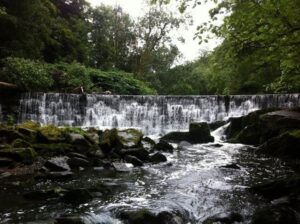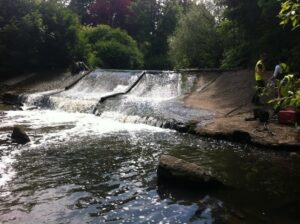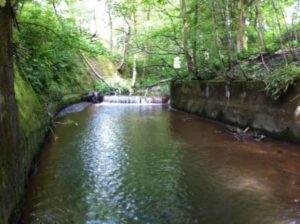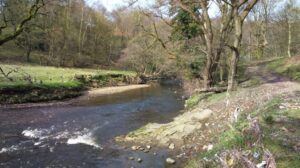
The weir is at the top of a picturesque sandstone gorge. Public access to the weir is good, with a well-used footpath running alongside the left-hand bank of the river. The weir itself is a well-photographed local landmark.
The weir once provided water to Higher Mill at Hoghton Bottoms, as well as Livesey’s Cotton Factory. The mill leat (channel that carried water collected behind the weir to the mill or factory) is now largely dilapidated but is still visible along its entire length from the weir to the viaduct over the river.
Due to its historic importance, large changes to the structure of the weir are not possible. The most feasible option for this is a rock-ramp fish easement (by reducing the steepness of the weir’s gradient, fish will have a better chance of getting up shorter stretches and pools to rest in on the way up). The bedrock outcrop may form part of the channel, over which fish will be able to swim. The main challenge here is the difficulty of access for construction vehicles and materials.

Removing the weir is thought to be too high risk for this site due to the structure and condition of the weir and proximity of local infrastructure. Therefore, we plan to construct a rock-ramp bypass channel that will give fish an alternative route around the side of the weir. During high flows, overspill from the river is also beginning to erode a channel behind the weir. The fish pass will help to stabilise the banking at this point and reduce the likelihood of the weir collapsing.
Historically, like many of the weirs on the River Darwen, this weir supplied water to a mill. Maps of Lower Darwen in 1845 indicate that it supplied a mill race for Ewood Cotton Mill (along with several other structures). By 1895, the weir supplied water to the Scotshaw Brook Paper Mill first and then continued to pass to Ewood Mill. This continued until at least 1945 when both mills were demolished, leaving the weir redundant.

Fish passage has been improved here by partially removing the weir structure and restoring the section to create a closer-to-nature river channel.

Removal of the weir structure has improved fish passage due to the restoration of a close-to-nature river channel, the low risk of geomorphological impacts and the relatively low cost.

